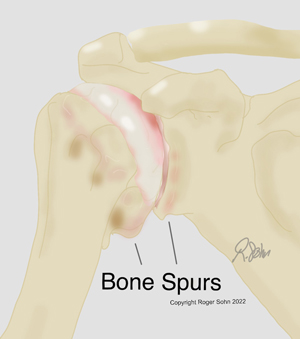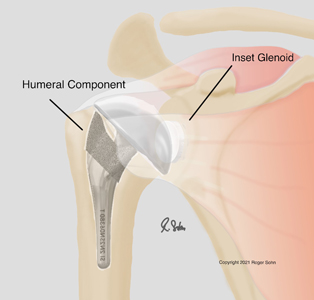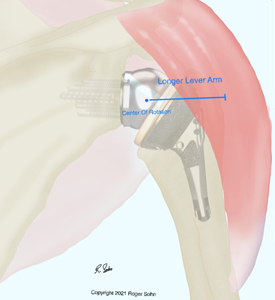Arthritis of the Shoulder More
By Roger C. Sohn, MD
What is Arthritis of the Shoulder?
When we are babies, most of our skeleton is made of cartilage which is very flexible and shock absorbing. As we grow into adults, our bones develop to their final length and only their ends are covered in cartilage. The joint cartilage, also known as articular cartilage, allows our joints to bear weight with a smooth and nearly frictionless motion. The term arthritis literally means inflammation of a joint but is generally used to describe any condition in which there is damage to the articular cartilage. The older we get, the more likely it is that the cartilage will start a process of thinning and eventually wearing away completely. When this happens, the underlying exposed bones can rub on each other, causing pain and loss of motion. Damage of the cartilage in the shoulder joint results in shoulder arthritis. Like other joints, the exposed glenoid (socket) and humeral head (ball) become rough when the cartilage wears out. This leads to inflammation, pain, and loss of shoulder motion.
What are the Types of Shoulder Arthritis?
There are several different types of arthritis. The most common are degenerative arthritis and inflammatory arthritis.
Dr. Sohn discusses 4 important things to know about shoulder arthritis and its treatment
What Is Degenerative Arthritis?
Degenerative arthritis is also known as Osteoarthritis. This is the most common type of arthritis, which occurs often as people get over the age of 50. This disease affects the cartilage, the tissue that cushions and protects the ends of bones in a joint.
With osteoarthritis, the cartilage starts to wear away over time. This process can happen without any injury to the joints. It simply happens due to a gradual loss of the cartilage with age. Some people are more likely to have this happen at a younger age due to the type of work or recreational activities they enjoy. Heavy lifting or repetitive impact on the joints can make degenerative arthritis more common. Injuries such as fractures or dislocations also damage the joint surface, leading to an early loss of cartilage. In extreme cases, the cartilage can completely wear away, leaving nothing to protect the bones in a joint, causing bone-on-bone contact. The joint can also develop bone spurs which are abnormal projections of bones near the edges of the joint. These bone spurs can grow quite large in the shoulder, restricting movement. When severe, the shoulder joint may lose most of its movement, leading to a loss of quality of life and function.
What Is Inflammatory Arthritis?

Inflammatory arthritis happens when the body attacks its own joint. The most common type of inflammatory arthritis is Rheumatoid arthritis. This is known as an autoimmune disease in which the body's immune system (the body's way of fighting infection) attacks healthy joints, tissues, and organs. This disease inflames the lining (or synovium) of joints. It can cause pain, stiffness, swelling, and loss of function in the joints. When severe, rheumatoid arthritis can deform or change the alignment of a joint.
Rheumatoid arthritis mostly affects the joints of the hands, knees, and hips and tends to be symmetrical. This means the disease affects the same joints on both sides of the body (both hands or both feet) at the same time and with the same symptoms. Women are more likely to get rheumatoid arthritis, but men can get it also.
Other types of inflammatory arthritis include psoriatic arthritis. This condition is associated with psoriasis, which usually affects the skin of the elbows, knees, or scalp. Also included in the inflammatory category is Reiter’s syndrome, which is more common in men. Inflammatory arthritis also includes ankylosing spondylitis, gout, and lupus. These are all types of arthritis caused by the immune system attacking the joints.
Although not as common as degenerative arthritis, inflammatory arthritis can also affect the shoulder joint. This can lead to similar symptoms as those described above. Without proper treatment, the joint cartilage can break down, leading to pain, stiffness, and loss of function.
Symptoms of Shoulder Arthritis
There are several forms of arthritis and the symptoms vary a bit according to the form of arthritis. Symptoms generally include swelling and pain or tenderness in the joints that lasts a long time. There can be times of “flare ups” where the pain is exacerbated by increased activities. This can be accompanied by redness or heat in a joint. As the arthritis gets worse, the shoulder can become stiff with a gradual limitation of motion of the joint.
In an arthritic shoulder:
- The cartilage lining is thinner than normal or completely absent. The degree of cartilage damage and inflammation varies with the type and stage of arthritis.
- The joint space is narrowed and irregular in outline; this can be seen in an X-ray image.
- Bone spurs or excessive bone can also build up around the edges of the joint.
- Crepitation, or a crunching sound, is felt with motion.
Diagnosis of Shoulder Arthritis
Your doctor will diagnose arthritis with a medical history, a physical exam and X-rays of the affected part. Computed tomography (CT) scans and magnetic resonance imaging (MRI) scans are sometimes ordered to find out how much damage there is to the joint and soft tissues.
Treatment Options for Shoulder Arthritis
Your doctor may prescribe anti-inflammatory medicine and may recommend occupational therapy or physical therapy, which includes exercises and heat treatment. In those with severe arthritis, joint replacement is a very good option. This involves the placement of an artificial ball and socket that are made of metal and polyethylene. During the surgery, the bone spurs are removed and the new implants are placed, restoring the smooth articulation of the ball and socket once more.
Read More on Total Shoulder Replacement
Depending on the severity of the joint damage, a reverse shoulder replacement may be necessary. Specifically, when the rotator cuff tendons are damaged or the socket is eroded, more stability is required. In a reverse shoulder replacement, the arrangement of the ball and socket are reversed allowing for a deeper socket. This also improves the mechanics of the joint deltoid muscle which can compensate for a damaged rotator cuff
Read More on Reverse Total Shoulder Replacement
Dr. Sohn describes the recovery process from shoulder replacement.
Related Topics
- Total Shoulder Replacement
- Reverse Total Shoulder Replacement
- Arthritis of the Shoulder
- Rotator Cuff Arthropathy
- Rotator Cuff Tears
- Suprascapular Nerve Compression
- Anterior Shoulder Instability
- SLAP Tears
- Proximal Biceps Tendinitis
- Internal Impingement of the Shoulder
- Partial Rotator Cuff Tears
- Shoulder Labral Tear with Instability
- Massive Retracted Rotator Cuff Tears
- Hill-Sachs Lesion




